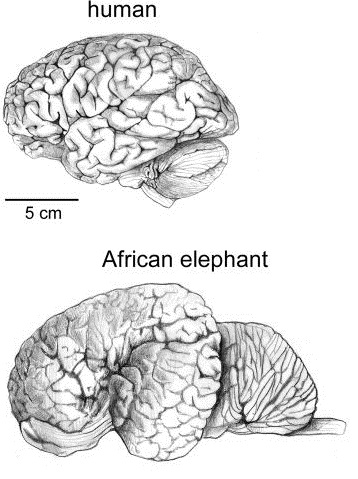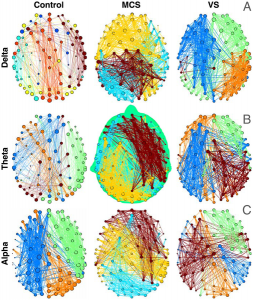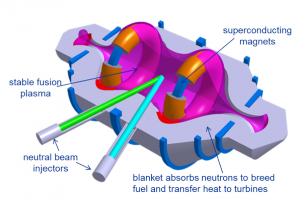Oct
31
2014
 I was recently asked about the relationship between brain size and intelligence. This is a question I get every now and then, because the relationship is not an obvious one. In this particular case, the questioner was curious about the fact that Neanderthals had a larger cranial capacity on average than modern Homo sapiens.
I was recently asked about the relationship between brain size and intelligence. This is a question I get every now and then, because the relationship is not an obvious one. In this particular case, the questioner was curious about the fact that Neanderthals had a larger cranial capacity on average than modern Homo sapiens.
For the sake of this discussion I am going to avoid a detailed treatment of the concept of “intelligence.” It’s important to note that intelligence is a multifaceted phenomenon, there is no single way to measure it, and it cannot be captured by any single number. Having said that, we can use various markers or measures of cognitive ability to loosely represent overall intelligence. Problem solving, for example, is one measure, and can be used in multiple species. I will come back to this later, for for the sake of this discussion I will be referring to intelligence as overall cognitive ability without getting specific.
Once scientists figured out that the brain is the seat of intelligence, we were quick to observe that humans had relatively large brains. This made sense – humans seem to be, by far, the most intelligent species on the planet, so it makes sense that we have the biggest brains.
Continue Reading »
Oct
30
2014
New Zealand Green MP, Steffan Browning, stepped in it recently when he signed a petition asking the World Health Organization (WHO) to develop and distribute homeopathic remedies to end the Ebola epidemic. Unfortunately this is not an Onion article.
Browning later tried to do damage control by stating that his support of the petition was “unwise” and he blamed it partly on it being late at night when he signed it.
Asked whether he thought homeopathy could cure Ebola, Mr Browning said: “It’s not for me to go down that track at all. The World Health Organisation, world health authorities are doing that.”
This is a common political response. Ask a Republican eyeing national office what they think about global warming or evolution and you might get a similar answer. It is a disingenuous dodge to essentially say, “I’ll let the scientists decide.” when they have already decided. It’s simply a way to stake out a neutral position and not piss anyone off.
Continue Reading »
Oct
28
2014
Surveys are always problematic because they are subject to interpretation, the precise phrasing of questions, sampling bias, and perhaps hidden assumptions on the part of those taking the survey. The results of any single survey, therefore, should be taken with a grain of salt. Still, they can provide a useful snapshot (if done well) of the current culture.
Skeptics are always interested in what the general public “believes.” The term “belief” is itself problematic, and when used in a survey it is subject to interpretation by those taking the survey. I am not one of those who object to ever using the term “belief.” It is a reasonable short hand for, “I find the totality of available evidence to be compelling,” or “I accept the scientific consensus on this issue,” at least in informal writing or conversation.
In a survey, however, I would prefer any questions about what people “believe” to be replaced by, or at least supplemented by, statements about what the scientific evidence says.
In any case, we have another recent survey about what Americans believe, from Chapman University. The survey covers a lot of territory, from religious affiliation and practice, to what people fear, to what they believe about scientific and paranormal topics. You can download the entire 73-page report of the results from the link above.
Continue Reading »
Oct
27
2014
After reading about genetically modified organisms for years, it seem pretty clear to me that the anti-GMO activist position is not an objective science-based position. Rather it has all the features of a political/marketing campaign. The campaign has talking points that are all spin and propaganda. Like a slick car commercial, it is selling a vibe, a worldview and a certain self-image.
Also like many political and commercial campaigns it is based on fear. Fear is a great motivator and politicians know the value of making the voters afraid of what will happen if their opponent is elected. Advertising agencies understand that you can sell a product by making it a solution to an imaginary fear. “Better safe than sorry” sells a lot of widgets.
The anti-GMO community seems closely tied to the organic food industry, which essentially sells the naturalistic fallacy on the back of irrational fears about everything artificial, whether or not there is any science behind those fears. Both, in turn, are tied to the alternative medicine community, which overlaps considerably in its fetish with all things natural, its demonizing of anything technological, and its apparent disdain for science (see Whole Foods as a good example of this overlap).
Continue Reading »
Oct
24
2014
Howard Wiseman, a theoretical quantum physicist at Griffith University in Brisbane, Australia, and his colleagues have come up with an entirely new theory to explain the weird behavior of particles at the quantum level. The idea is that quantum effects result from classical universes interacting with each other.
Classical physics is essentially the physics of Newton and describes the macroscopic world. In classical physics particles have a definitive location and momentum. At the scale of fundamental particles, however, the world behaves very differently.
At this so-called quantum level, particles move in waves but then interact as particles. They have only a probabilistic location and cannot be nailed down specifically. There is a minimum amount of uncertainty when trying to measure any linked properties, such as location and momentum. Even more bizarre is quantum entanglement in which particles have linked properties, even when separated across the universe.
The bottom line is that we do not really know why the quantum world behaves as it does. We have experimental data, such as the double-slit experiments, that show consistent results. When light beams shine through two close narrow slits they interfere with each other as if they are moving like waves, even when the beams are so faint that only one photon will be passing through the silts at a time. One photon can apparently cause a wave interference with itself. But when those same photons strike a film plate or detector, they behave like a particle.
Continue Reading »
Oct
23
2014
 Can playing video games or specifically designed computer games improve your cognitive function? There are many companies who claim that they can and who would like to sell you such games that they claim are “scientifically designed.”
Can playing video games or specifically designed computer games improve your cognitive function? There are many companies who claim that they can and who would like to sell you such games that they claim are “scientifically designed.”
So-called brain-training is a burgeoning business, with perhaps the best known product being Lumosity. Lumosity promises:
“Scientifically designed games: Lumosity scientists study many common neuropsychological tasks, design some new ones, and transform these tasks into fun, challenging games.”
They claim to be a “leader in the science of brain training,” and include a list of 13 studies that allegedly show Lumosity is effective. Many of the studies do not even test efficacy, and strangely the list does not include this recent study from August 2014 showing that Lumosity is not effective.
This new study involved 77 subjects randomly assigned to play 8 hours of Lumosity or Portal 2 (a popular video game). They found that the Portal 2 players outperformed the Lumosity players on all three cognitive evaluations: problem solving, spatial skills, and persistence. The only pre-test to post-test significant improvement was the Portal 2 group for spatial skills.
Continue Reading »
Oct
21
2014
 This news item combines two technologies that I have been eagerly following, graphene and brain-machine interface. Researchers have developed a 1-molecule thick graphene electrode that is transparent and can be used for high-resolution electrophysiological recordings of brain cell activity.
This news item combines two technologies that I have been eagerly following, graphene and brain-machine interface. Researchers have developed a 1-molecule thick graphene electrode that is transparent and can be used for high-resolution electrophysiological recordings of brain cell activity.
Before I explain why this is such a cool advance, I will quickly review these technologies. Graphene is an allotrope of carbon – it is made of a single atom thick layer of carbon atoms arranged in a hexagonal sheet like chickenwire. This arrangement is very stable with strong bonds, making for a strong material. It is also flexible and has useful electrical properties. It can be manufactured as a sheet or rolled up into carbon nanotubes.
Graphene is an incredibly promising material that is likely to be the cornerstone of future electronics, promising small, efficient, and flexible components. It conducts both heat and electricity very efficiently and it is a semiconductor. “Doping” the graphene with other elements also has the potential to tweak its physical properties, expanding the number of applications.
Continue Reading »
Oct
20
2014
 One of the most difficult issues that skeptical physicians face is dealing with children sick with cancer whose parents refuse standard therapy. These cases are always highly charged, because the stakes are extremely high. Obviously the stakes are highest for the child as their life is literally on the line. The stakes are also high for society, however, because they force a specific decision regarding the relative rights of parents vs the responsibility of the state to care for minors.
One of the most difficult issues that skeptical physicians face is dealing with children sick with cancer whose parents refuse standard therapy. These cases are always highly charged, because the stakes are extremely high. Obviously the stakes are highest for the child as their life is literally on the line. The stakes are also high for society, however, because they force a specific decision regarding the relative rights of parents vs the responsibility of the state to care for minors.
Two recent cases once again raise these issues. One comes from Western Australia where 10-year-old Tamara Stitt was diagnosed with liver cancer. Her oncologist recommended chemotherapy. Her parents were (understandably) concerned about the side effects of chemotherapy.
He said he and his wife decided against chemotherapy for their daughter because of its horrific side effects and because he felt threatened by doctors.
Mrs Stitt testified that she believed her daughter had a 100 per cent chance of being cured with natural therapies, and she had initially responded well to such treatment.
Her parents decided against chemotherapy and instead chose “alternative” therapies including clay wraps, herbal teas and a healthy diet. Tamara’s cancer predictably progressed until her parents finally relented. Tamara received chemotherapy in El Salvador, but it was too late, and unfortunately she died of her cancer.
Continue Reading »
Oct
17
2014
 A vegetative state is a particular kind of coma in which patients appear to be awake but give no signs (by definition) of any awareness. They do not respond to their environment in any way or do anything purposeful. Some patients display a flicker of awareness, and they are categorized as minimally conscious.
A vegetative state is a particular kind of coma in which patients appear to be awake but give no signs (by definition) of any awareness. They do not respond to their environment in any way or do anything purposeful. Some patients display a flicker of awareness, and they are categorized as minimally conscious.
Neuroscientists have been using the latest technology to look at brain function in vegetative subjects and comparing that function to healthy controls. In this way they hope to gain insight into the neurological correlates of consciousness – what brain activity is necessary for and responsible for conscious awareness. A new study, published in PLOS Computational Biology, replicates this research with interesting findings.
As with previous studies, the researchers found that the majority of vegetative patients had profound abnormalities of brain function compared to healthy controls. They found:
Here, we apply graph theory to compare key signatures of such networks in high-density electroencephalographic data from 32 patients with chronic disorders of consciousness, against normative data from healthy controls. Based on connectivity within canonical frequency bands, we found that patient networks had reduced local and global efficiency, and fewer hubs in the alpha band.
This means they measured the electrical activity of the brain and found that patients in a vegetative or minimally conscious state had decreased brain activity. A healthy brain has massive local and global networks of neurons exchanging information across the brain. The brains of patients with impaired consciousness had markedly reduced activity and fewer hubs of activity.
Continue Reading »
Oct
16
2014
 Since I recently covered the new claims being made for the E-cat cold fusion device (which, in my opinion, is almost certainly bogus), I found it interesting that Lockheed Martin recently produced details for their research into a hot fusion reactor. Their research team, called the Skunk Works, have been working on a new design for a fusion reactor. It has two distinct advantages over the E-cat – it does not require the assumption of new physics, and it is not being promoted by a convicted con-artist.
Since I recently covered the new claims being made for the E-cat cold fusion device (which, in my opinion, is almost certainly bogus), I found it interesting that Lockheed Martin recently produced details for their research into a hot fusion reactor. Their research team, called the Skunk Works, have been working on a new design for a fusion reactor. It has two distinct advantages over the E-cat – it does not require the assumption of new physics, and it is not being promoted by a convicted con-artist.
Fusion is a type of nuclear reaction that involves combining lighter elements into heavier elements. The resulting reaction releases a significant amount of energy, and that energy can be used to generate electricity. Fusion, in fact, is the power source for stars. The immense temperature and pressure in the core of stars fuse hydrogen into helium, and then helium into heavier elements, depending on how massive the star is. The heaviest element that can be made in this fashion is iron. Elements heavier than iron require energy to fuse, and therefore you cannot get any energy out of iron from fusion or fission. Heavier elements are therefore made in the powerful explosions of supernovae.
If we could engineer a device that could produce sufficient temperature and pressure we could theoretically create nuclear fusion on earth. In fact we have already done so, in the form of hydrogen bombs. Of course, creating a massive explosion isn’t exactly useful as an energy source. The trick is creating controlled nuclear fusion without the huge explosion.
Continue Reading »
 I was recently asked about the relationship between brain size and intelligence. This is a question I get every now and then, because the relationship is not an obvious one. In this particular case, the questioner was curious about the fact that Neanderthals had a larger cranial capacity on average than modern Homo sapiens.
I was recently asked about the relationship between brain size and intelligence. This is a question I get every now and then, because the relationship is not an obvious one. In this particular case, the questioner was curious about the fact that Neanderthals had a larger cranial capacity on average than modern Homo sapiens.










